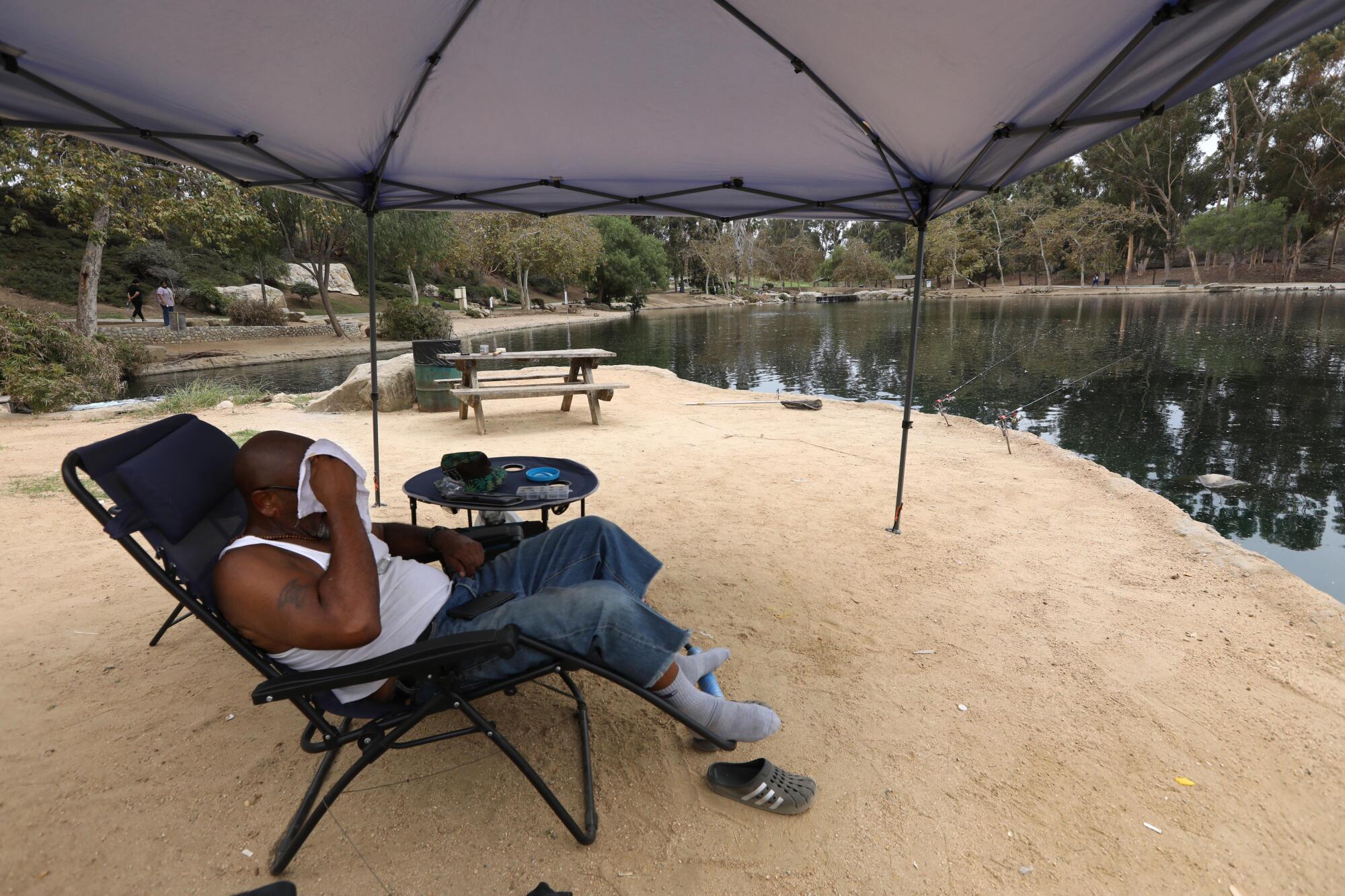The nation’s top emergency response agency has long been a lifeline for cities and states struggling with disaster. When hurricanes strike, earthquakes rattle, and tornadoes carve paths of destruction, the Federal Emergency Management Agency moves in to provide critical resources and aid.
Yet for all its assistance, FEMA’s official definition of a “major disaster” does not include two threats that are increasingly posing harm to millions of Americans: extreme heat and wildfire smoke.
In a rule-making petition filed Monday, the Center for Biological Diversity and more than 30 other environmental organizations, healthcare groups and trade unions argued that it’s time to change that. They are requesting that the Stafford Act — FEMA’s animating statute — be amended to include extreme heat and wildfire smoke in its regulations.
Doing so, they say, would unlock crucial disaster relief funding that would allow local governments to invest in cooling centers and air filtration systems, work toward resilient energy solutions such as community solar and storage, and better prepare for emergencies.
“These twin climate-fueled catastrophes now consistently, year after year, vastly exceed the economic and technical capabilities of state and local governments to manage them, adapt to them, and mitigate further harm,” the petition says. “Federal action is necessary.”
Currently, the Stafford Act defines major disasters as “any natural catastrophe (including any hurricane, tornado, storm, high water, winddriven water, tidal wave, tsunami, earthquake, volcanic eruption, landslide, mudslide, snowstorm, or drought), or, regardless of cause, any fire, flood, or explosion, in any part of the United States.”
Attorneys for the Center for Biological Diversity argue that the definition is already broad enough to include heat and wildfire smoke, but said agency officials have historically been hesitant to provide aid in those situations, when property damage and other material outcomes can be harder to define.
In 2022, FEMA rejected a request from California for a major disaster declaration in response to a heat wave that baked the state for 10 days, killing 395 people and pushing the power grid to its limits. In its rejection, the federal agency said the “precedent is to evaluate discrete events and impacts, not seasonal or general atmospheric conditions,” according to the petition.

A Mesa, Ariz., resident enjoys cool air in her home after her air conditioner was repaired in the middle of a July 2023 heat wave.
(Ash Ponders/For The Times)
But the Stafford Act has been amended in the past, and FEMA hasn’t been afraid to use it in other extenuating emergencies, including the COVID-19 pandemic.
In 2020, then-President Trump approved COVID-19 major disaster declaration requests for all states, tribes and territories under the Stafford Act. President Biden later approved similar requests from the Navajo Nation and the Poarch Band of Creek Indians, and made available $3.46 billion in hazard mitigation funding for all areas that had received COVID disaster declarations.
“Together, the Biden and Trump administrations recognized that infectious diseases constitute major disasters under the Stafford Act, despite the fact that these events are not listed in the definition of ‘major disaster,’ ” the petition said.
In that manner, the federal government has already accepted the interpretation that there are major disasters beyond those enumerated in the definition, “so they’ve already inherently accepted our argument,” said Jean Su, a senior attorney with the Center for Biological Diversity and the lead author of the petition.
“And so the question is, why can’t FEMA actually act on that for extreme heat and wildfire smoke — extreme heat being the No. 1 killer of weather overall in the United States,” she said.
Indeed, extreme heat is already taking a considerable toll on U.S. citizens, and its effects are only expected to worsen in the coming years as climate change and other factors drive global temperatures even higher.
According to the National Weather Service, extreme heat has contributed to more deaths over the last 30 years than hurricanes, floods and tornadoes combined, with 2023 representing the highest number of heat fatalities. Heat poses a particular threat to children, pregnant people, elderly people and people with underlying health conditions, as well as outdoor workers, low-income populations and communities of color.
Last year, a record-breaking heat wave smothered Phoenix in temperatures of 110 degrees or hotter for 31 consecutive days, contributing to more than 600 deaths and a surge of people suffering from heat-related illnesses and pavement burns. The petition was born in the wake of that event, Su said.
Other signatories include the National Council for Occupational Safety and Health, the Service Employees International Union and the United Farmworkers Foundation.

A man wipes sweat from his face while fishing under a canopy at Kenneth Hahn State Recreation Area in Los Angeles during a September 2022 heat wave.
(Genaro Molina/Los Angeles Times)
Will Humble, executive director of the Arizona Public Health Assn., said he signed the petition because heat and smoke will continue to pose health threats to the population, and “in both cases there are times when state resources are insufficient to deal with the problems.”
“Given that this is going to become more and more frequent because of the urban heat island and climate change and the recalcitrance of these local jurisdictions, there’s going to be more and more times when I think we need a burst of federal resources coming in,” he said.
Portions of the United States have already baked under extreme temperatures this year, including record-highs in Las Vegas and Phoenix, which soared to 111 degrees and 112 degrees in early June, respectively. A severe heat dome is expected to blanket much of the Midwest and East Coast this week.
What’s more, forecasters on the West Coast are already predicting a potentially active wildfire season fueled by heat-dried vegetation. The California Department of Forestry and Fire Protection has responded to nearly 1,800 fires so far this year.
With those blazes comes the danger of smoke — another pernicious threat that can lead to deadly outcomes. In fact, a recent study found that the fine particulate matter that spewed from California’s wildfires between 2008 and 2018 was responsible for as many as 55,700 premature deaths in the state.
Smoke from wildfires in California and other places, including Canada, has blown far beyond the confines of the flames, with noxious particles reaching as far as the East Coast of the U.S. and Europe. And with more intense fire activity expected in the years ahead, the threat of smoke grows in kind.
“Like extreme heat, smoke from wildfires is also a natural catastrophe that is becoming more frequent and severe due to anthropogenic climate change,” the petition says.
The costs of these dangers are also on the rise, with current and projected losses tied to healthcare, agriculture, infrastructure repairs, workplace productivity and other outcomes measuring in the hundreds of billions of dollars, according to the petition.
“When you combine the climate crisis with the magnitude and the frequency of natural disasters … it is nonstop,” said Christine Bolaños, communications director with the Workers Defense Project, an advocacy organization based in Texas, which experienced its largest wildfire on record earlier this year. “And so we need some kind of federal regulation to help provide resources and support to these vulnerable communities.”
Bolaños said signing the petition was a “no-brainer,” particularly given the disproportionate affect that heat, smoke and other hazards have on migrant workers and other at-risk populations.
“We absolutely think that when there is more support — and a spotlight on potential solutions at the federal level — then there is hope at the state and the local levels, because some of these issues we can only solve when we’re all working together rather than in silos,” she said.
FEMA currently draws the majority of its resources from the Disaster Relief Fund, which is doled out by Congress each year and can be carried over year-to-year. Since 2020, annual allocations to the fund have ranged from $20 billion to $70 billion. FEMA’s spending also fluctuates, with expenditures in 2021 reaching $69 billion due in part to the pandemic, and just $19 billion in 2022. FEMA spending last year was $41 billion.
“It’s all a matter of Congress, and because extreme heat is truly a bipartisan issue, I would hope that Congress does appropriate accordingly to actually help their own states get money for these extreme heat and wildfire smoke issues,” Su said.
Amending the Stafford Act to include extreme heat and wildfire smoke would open up new avenues for short- and long-term buckets of funding, the petition says. For instance, short-term funding could provide temporary cooling centers, water stations and clean-air centers that could be placed in urban cores or areas where workers are suffering disproportionately from extreme heat or smoke.
But FEMA funding could also assist with longer term mitigation projects that not only help respond to disasters, but also prepare for them. These include permanent community resilience centers, air conditioning and filtration upgrades in public schools, or improved energy systems through rooftop solar and micro-grids, which would also help people afford the electricity needed for cooling and filtration, Su said.
“It’s a far more innovative and proactive way of emergency management that they, as an institution, are not accustomed to,” she said. “Just because you aren’t accustomed to it, though, doesn’t mean that you don’t have the authority to do it and that you shouldn’t do it.”
Su added that the broad statutory language in the Stafford Act already allows for these kinds of responses, as evidenced by the actions during the COVID-19 pandemic. Officially amending the language of the act would required FEMA to open up a rule-making process, which could be bolstered by experts who help outline and define clear thresholds and qualifications for high temperatures and wildfire smoke particulate matter.
The petition is expected to received broad support from state and local leaders, she said.
Some have already been pushing FEMA to make the change through the bipartisan Extreme Heat Emergency Act, which similarly urges the agency to add extreme heat to its list of major disaster qualifying events. Introduced by Arizona Rep. Ruben Gallego last year, the act has been endorsed by officials in several states including Nevada, Texas and California.
However, Humble noted that many of these issues do not exist in vacuums, that cities and states also bear some responsibility for preparing for and responding to crises. In Phoenix, as in California, housing shortages, homelessness and other challenges are also leaving more people exposed to extreme heat and smoke, he said.
“The job of preventing these heat-related deaths is really a state and local one, but if we’re going to have FEMA — and if FEMA is going to have disaster responses — it really should include extreme heat emergencies,” he said.
Newsletter
Toward a more sustainable California
Get Boiling Point, our newsletter exploring climate change, energy and the environment, and become part of the conversation — and the solution.
You may occasionally receive promotional content from the Los Angeles Times.






